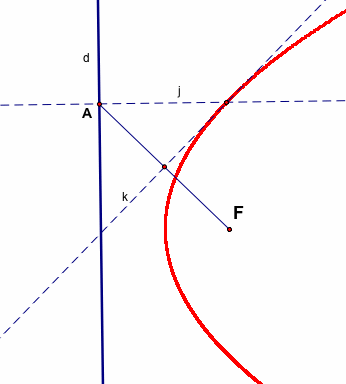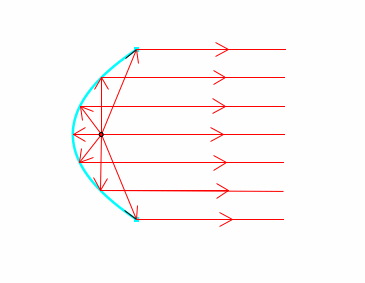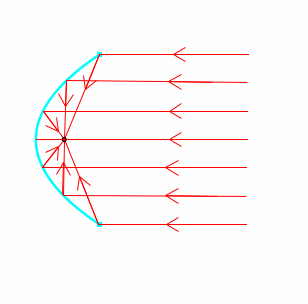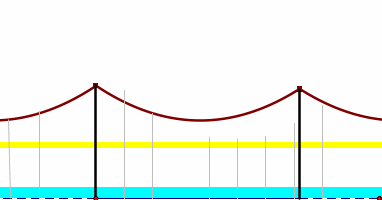

Reflective property of a parabola
by
Nathan Wisdom
The parabola is the set of points in the plane that are equidistant from a fixed line, (the directrix) and a fixed point (the focus) not on the line. Therefore for a point to be on a parabola, the distance from the point to the focus must be equal to the distance from the point to the directrix. We will use GSP to investigate and construct the parabola from this definition.
Begin with a line (the directrix), and a point labeled F Select an arbitrary point A, on the directrix, and construct a segment from that point to the focus (segment AF). Now we know that any point on the perpendicular bisector of segment AF is equidistant from the end points. Thus we now construct the perpendicular bisector of segment AF. The point on the parabola must be on this bisector. We also know that the distance of a point to a line, is the perpendicular segment from the point to the line. Therefore we construct line j through the point A perpendicular to the directrix d. The point where j intersect k, is the required point on the parabola.
|
 |
| We can trace the point as A moves along the diretrix, to see the parabola. |  |
The parabola has a very interesting reflexive property. Recall the law of reflection which states that the angle of incidence is equal to the angle of reflection measured form the normal. Recall also that the normal is perpendicular to the surface. The reflective property of the parabola has numerous practical applications. Since light is a wave, if a light source is placed at the focus of a paraboloid the result will be a focused beam of light emerging outward along the direction of the axis. As in the figure below. This is how flashlights, headlights, and searchlights work.

The opposite is also true. A parallel beam of light or any other kind of wave incident on a paraboloid will converge on the focus after being reflected.

This property is used in reflecting telescopes and satellite dishes. In the optical telescopes, the light is reflected from the parabolic mirror to the focus, where another mirror reflects it through a lens to the observer.
Le us compare this interesting property of the parabola with the law of reflection.We first state the following theorem.
Theorem: The tangent line at a point P on a parabola makes equal angle with the line through P parallel to the axis of symmetry and the line through P and the focus.
Proof:
 |
Line EP is tangent to the parabola at P. The point P is a point on the parabola, and P is equidistant from F an D (by definition). Therefore segment PE is the altitude of isosceles triangle PFD, and angle FPE is congruent to angle EPD. Since vertical angles are congruent, angle EPD is congruent to angle CPA. |
We therefore have a very similar law of reflection for the parabola.
We will use GSP to illustrate the operation of the head lights. You can move the light source to investigate why the light bulb must be placed at the focus.

GSP FILE (Take a Look)
Besides their reflective property, parabolas have many other useful applications. Neglecting air resistance, the projectile of a body in free-fall near the surface of the earth is a parabola. This is due to the law of falling bodies. A falling body has two components of its motion, one horizontal and one vertical. In the horizontal direction, its velocity is constant, but in the vertical direction, it accelerates toward the ground at a rate of 9.8 meters per second per second. The resulting curve is a downward-pointing parabola.

Another useful application of parabolas is in the design of suspension bridges.

As it turns out, the shape of the cable of a completed suspension bridge is a parabola, although before the road is in place, it has a different shape, known as a catenary. Similar to a parabola but opening up somewhat faster, a catenary is the shape of a dangling chain. The graph below shows a catenary.

It can be shown that hanging cables form parabolic arcs rather than catenaries, if they are subjected to uniformly distributed downward forces along their lengths. For example, if the weight of the roadway in a suspension bridge is assumed to be uniformly distributed along the supporting cables, then the cables can be modeled by parabolas.